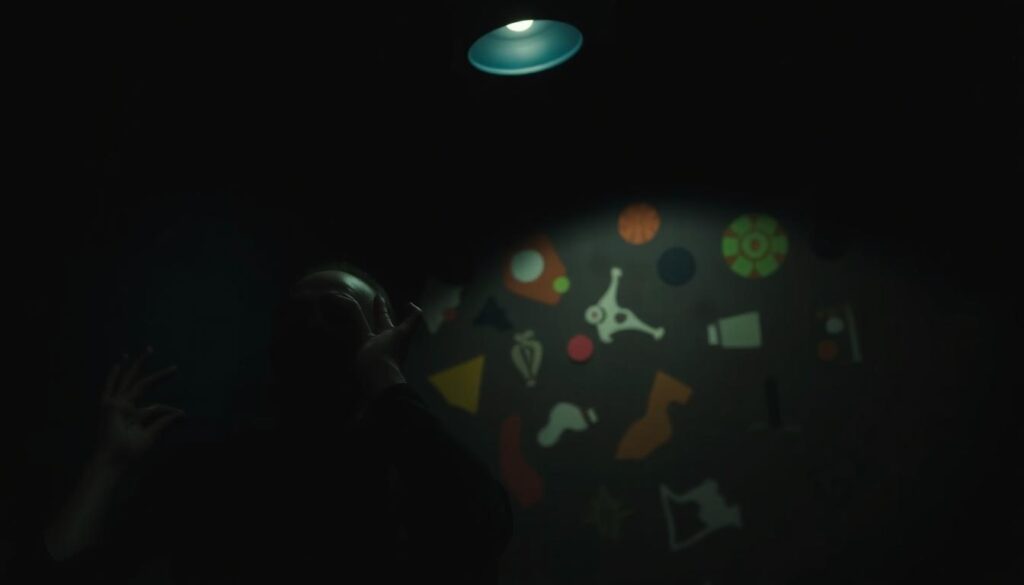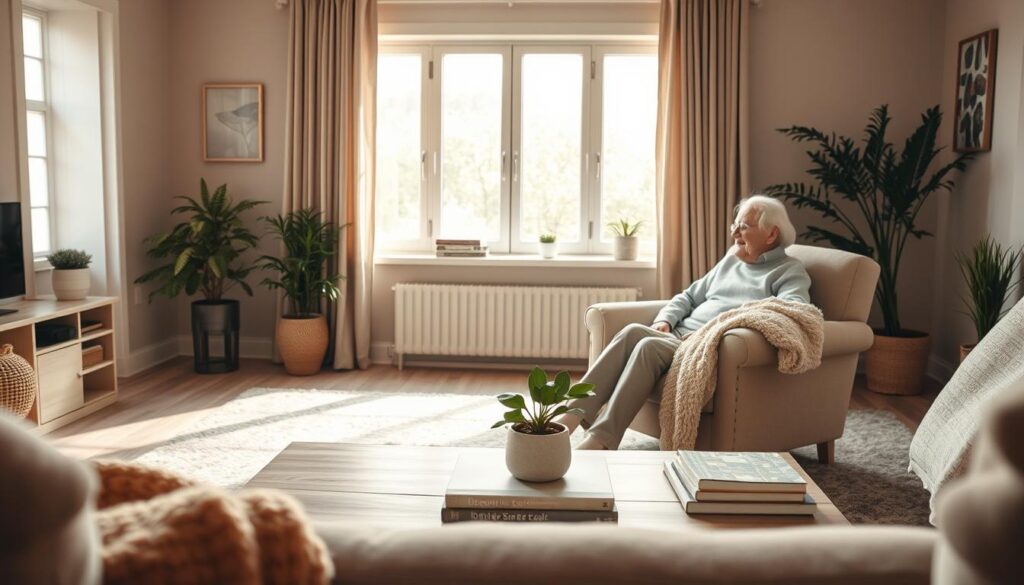Welcome to Dementia World elderly home services



Many people with dementia struggle with sensory processing. This can cause them a lot of distress. The booklet “Dementia and Sensory Challenges” by Agnes Houston explains how dementia affects people’s senses.
People with dementia face more than just memory loss. Their sensory experiences are complex. Caregivers and healthcare professionals can help by understanding these challenges. This way, they can improve the lives of those with dementia.
It’s key to grasp the sensory hurdles of dementia for better care. Dementia messes with how we sense the world, causing many issues. These can really impact someone’s life quality.
Dementia messes with how our brain handles sensory info. This can lead to confusion and odd behaviour. The brain’s complex ways of sensing things get disrupted by dementia.
People with dementia might struggle with seeing things clearly or hearing too well. Some might find it hard to handle certain sounds or smells.
Different dementia types bring unique sensory problems. For example, Alzheimer’s can mess with vision, while Lewy body dementia makes sounds overwhelming.
| Type of Dementia | Common Sensory Difficulties |
|---|---|
| Alzheimer’s Disease | Visual disturbances, difficulty with depth perception |
| Lewy Body Dementia | Hypersensitivity to noise, visual hallucinations |
| Frontotemporal Dementia | Tactile sensitivities, changes in eating habits due to taste or smell disturbances |

Knowing these challenges helps caregivers offer better support. This can greatly improve the life of someone with dementia.
People with dementia often face sensory challenges that can cause overload. It’s important to know the signs. Sensory overload happens when the brain gets too much information, causing distress and making dementia symptoms worse.
To deal with sensory challenges in dementia, it’s key to spot the signs of overload. Recognising these signs helps caregivers act early. This can prevent things from getting worse and make the person more comfortable.
Those with dementia might show changes in behaviour when they’re feeling overwhelmed. Signs include agitation, anxiety, withdrawal, and restlessness. These can be hard for both the person and their caregivers.
It’s vital to see these signs as possible signs of dementia sensory issues. Caregivers need to know these behaviours might not just be because of dementia. They could also mean the person is feeling too much sensory input.

Telling sensory overload apart from other dementia symptoms can be tricky. But, it’s important to offer the right support. Sensory overload can look like agitation or withdrawal, which are also dementia symptoms.
The main difference is in the context and what triggers these behaviours. For example, if someone gets agitated in a loud place, it might be sensory overload. Knowing these details helps caregivers support better.
| Symptom | Sensory Overload | Other Dementia Symptoms |
|---|---|---|
| Agitation | Often triggered by excessive sensory stimuli | Can be a general symptom of dementia progression |
| Withdrawal | May occur as a response to overwhelming sensory input | Can be a sign of depression or dementia progression |
| Restlessness | Can be a result of discomfort due to sensory overload | Often associated with boredom or unmet needs |
Understanding the difference between sensory overload and other dementia symptoms is key. This knowledge helps caregivers come up with better strategies for coping with sensory challenges in dementia. It’s essential for giving the best care possible.
Creating environments that meet the sensory needs of people with dementia is key. A well-designed space can reduce sensory overload, improving their life quality.
Visual and lighting elements are vital for comfort in dementia care. Reducing glare and adjusting lighting levels can lessen confusion and distress. Sheer curtains or blinds control natural light, while dimmer switches offer flexibility.
Using a mix of natural and artificial light is beneficial. An expert says, “The right lighting can greatly improve a space’s comfort and ease of navigation for dementia patients.”
“Lighting should be bright enough to allow individuals to see clearly, but not so bright that it causes glare or discomfort.”
| Lighting Adjustment | Benefit |
|---|---|
| Reducing glare | Minimizes visual discomfort |
| Adjusting lighting levels | Enhances visibility and reduces confusion |
| Using natural light | Creates a more welcoming environment |
Controlling noise levels is critical for a sensory-friendly space. Background noise can cause anxiety and overwhelm in dementia patients. Implementing noise reduction strategies like soundproofing or white noise machines can help.

People with dementia may be more sensitive to touch and temperature. It’s important to design their environment with comfort in mind. Ensuring the environment is comfortable in terms of temperature and touch can prevent discomfort and agitation.
For example, providing different textures through clothing and furnishings can make individuals with dementia more comfortable. A caregiver notes, “Paying attention to the tactile experiences of individuals with dementia can significantly impact their comfort and reduce agitation.”
Making living or care environments simpler can greatly benefit dementia patients. Clear signage and minimal clutter are key to creating a more navigable space.
By using these strategies, caregivers can create environments that are more comfortable and supportive. This can lead to a better quality of life and less sensory overload.
The right methods and ways to talk can really help people with dementia live better lives. By focusing on the person, caregivers can help with sensory issues.
When someone is overwhelmed by too much, talking clearly is key. Caregivers should stay calm and reassuring. They should use simple words to ease the person’s worry.
It’s also important to listen and show you understand. This helps a lot. Gentle touch or being there can also help without making things worse.
Activities that use the senses can make life more fun for people with dementia. Things like gardening, listening to music, or touching different textures are great.
These activities not only make the senses happy but also help people feel connected and express their feelings. This makes them feel better overall.

Multisensory therapy uses many senses at once for a full experience. Snoezelen is a good example, mixing sights, sounds, and touch. It can really help calm people down and improve their mood.
By choosing activities that fit what the person likes, caregivers can make therapy fun and supportive.
In the UK, there are lots of resources and help for caregivers dealing with dementia. The Alzheimer’s Society is one place that offers advice, training, and places to meet others.
Using these resources can help caregivers do their job better. They can learn more and support people with dementia more effectively.
It’s key to understand and manage sensory challenges in dementia for top-notch care. Recognising how dementia affects sensory processing helps a lot. This way, caregivers can really help those with dementia, making their lives better.
Dealing with sensory issues in dementia needs a broad approach. This includes being aware, accepting, adapting, and avoiding things that might upset them. By using the tips from this article, caregivers and healthcare teams can really help people with dementia.
Handling sensory problems in dementia boosts the person’s life quality and helps caregivers too. We must keep spreading the word and finding ways to manage these challenges. This way, we can make a better world for those with dementia.